Cabot Cliffs – Why It’s Canada’s #1 Golf Course
This post first appeared after playing Cabot Cliffs in September, 2016. In September of 2020 Alison and I returned, taking along our daughter Lenore who, although not a regular golfer wanted desperately to play the two world top 100 courses at Cabot Links. She even took a couple of lessons from Kyle Scott, one of the teaching pros at my home course Ashburn in Halifax so she wouldn’t embarrass herself or us on these prestigious courses. There were a number of reasons we wanted to play Cabot Cliffs again aside from the fact that is the best course in Canada. The first was that we had featured it along with Cabot Links and Highlands Links in a chapter on our latest book The Nova Scotia Bucket List.

We wanted to reconfirm our great memories of the first time we played it and make sure that the comments we were making about the course in a number of television and radio interviews were accurate. Actually, I had very little concern about this as I had discussions with many other golfers from the Golf Journalists Association of Canada between 2016 and 2020 and knew that everyone who played was blown away. The second reason was that we wanted to see how the resort was faring as a result of the loss of any business from outside of Atlantic Canada due to the season long lock down caused by Covid-19. What we found was a course that is still mind blowing and a golden opportunity for Atlantic Canadians to take advantage of the the next seven weeks to get out and play not only Cabot Cliffs, but Cabot Links and Highlands Links as well. What follows is my updated hole by hole description of the course.
Every two years Score Magazine publishes a list of the top 100 golf courses in Canada. The ratings are established by a panel of no less than eighty different golfers, most of whom are very good golfers, but some who are just ordinary 90 to 100 scorers who love the game. So how is it possible that a golf course that did not even exist for the 2014 rankings ends up being #1 in 2016 and holds that ranking through 2020? In 2016 I was about to find out as I, and a group of good friends, played Cabot Cliffs, a tour de force from the Coore and Crenshaw design team.
The story begins with a chance pairing of Rodney MacDonald and Ben Cowan-Dewar at some non-memorable event in Toronto about fifteen years ago. Rodney, who’s highest and best use is as a fiddler and gym teacher, had inexplicably become premier of Nova Scotia. Ben Cowan-Dewar is an entrepreneur and business partner of Mike Keiser who is responsible for building some of the best golf courses in the world. Keiser’s so good at what he does that he’s pissed off Donald Trump to no end. Trump buys existing courses, tarts them up and declares them “so great”, but they never rate anywhere near the top in independent rankings. Keiser builds them from scratch and gets them in the top 100 in the world from day one. Here’s a good article in Fortune, written before Trump became President, that describes their rivalry. He must be even more upset that now, as the most powerful man on the planet (God forbid, but it’s true), there’s nothing he can do to change the fact that Keiser courses are still much higher rated than his.
Anyway, it’s Cape Breton’s good fortune that Ben and Mike were persuaded by Rodney to come to the then slowly dieing former coal mining town of Inverness and take a look at the mile long beach that fronts the community. At that time it was a complete mess, strewn with the detritus of a century of coal mining. They, however, did not see what was in front of them, but rather what could be and so Cabot Links was created. Opened in 2012, it was the first true links course in Canada and immediately vaulted into second place in the Score 2014 ratings.
The success of Cabot Links led to the idea of a second course on somewhat higher ground a mile north that had a striking resemblance to the terrain at Pebble Beach, arguably the most scenic golf course in the world. When Bill Coore and Ben Crenshaw were brought in to look at it, they were blown away with the potential. It’s now 2020 and that potential has been realized in a course that has rocketed to the #1 ranking in Canada and incredibly, #9 in the world.
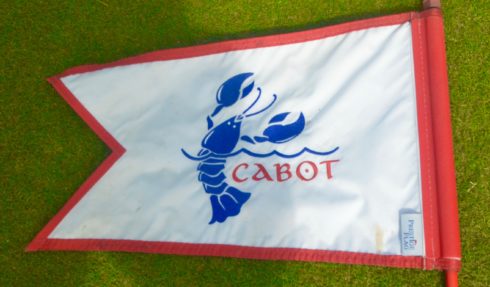
The Ambience at Cabot Cliffs
While the experience of playing a golf course is undoubtedly the primary reason one might want to come back or not, there are other more subtle things that also figure into the equation. I found that to be especially true at Cabot Cliffs. It starts with the blue lobster logo, which I have to admit, at first glance, I thought was stupid. But then, thinking about why they would choose this as their logo, two things came to mind. First of all blue lobsters are extremely rare and secondly they are a symbol of good luck for the fishermen who might catch one in a lifetime. So here we were in 2016, on an absolutely gorgeous day in late September, with the good fortune to be playing one of the best golf courses in the world. These chairs and sofas are set up with a view of almost the entire golf course.
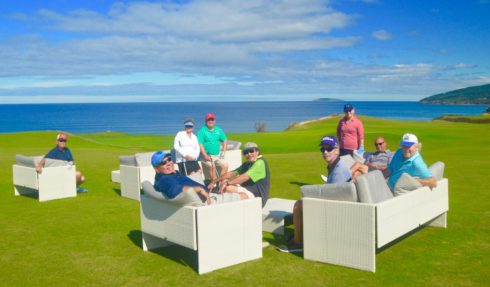
Fast forward to 2020 and here we are again on what promises to be a great Labor Day weekend with a few showers this morning and then nothing but sun for the next three days.
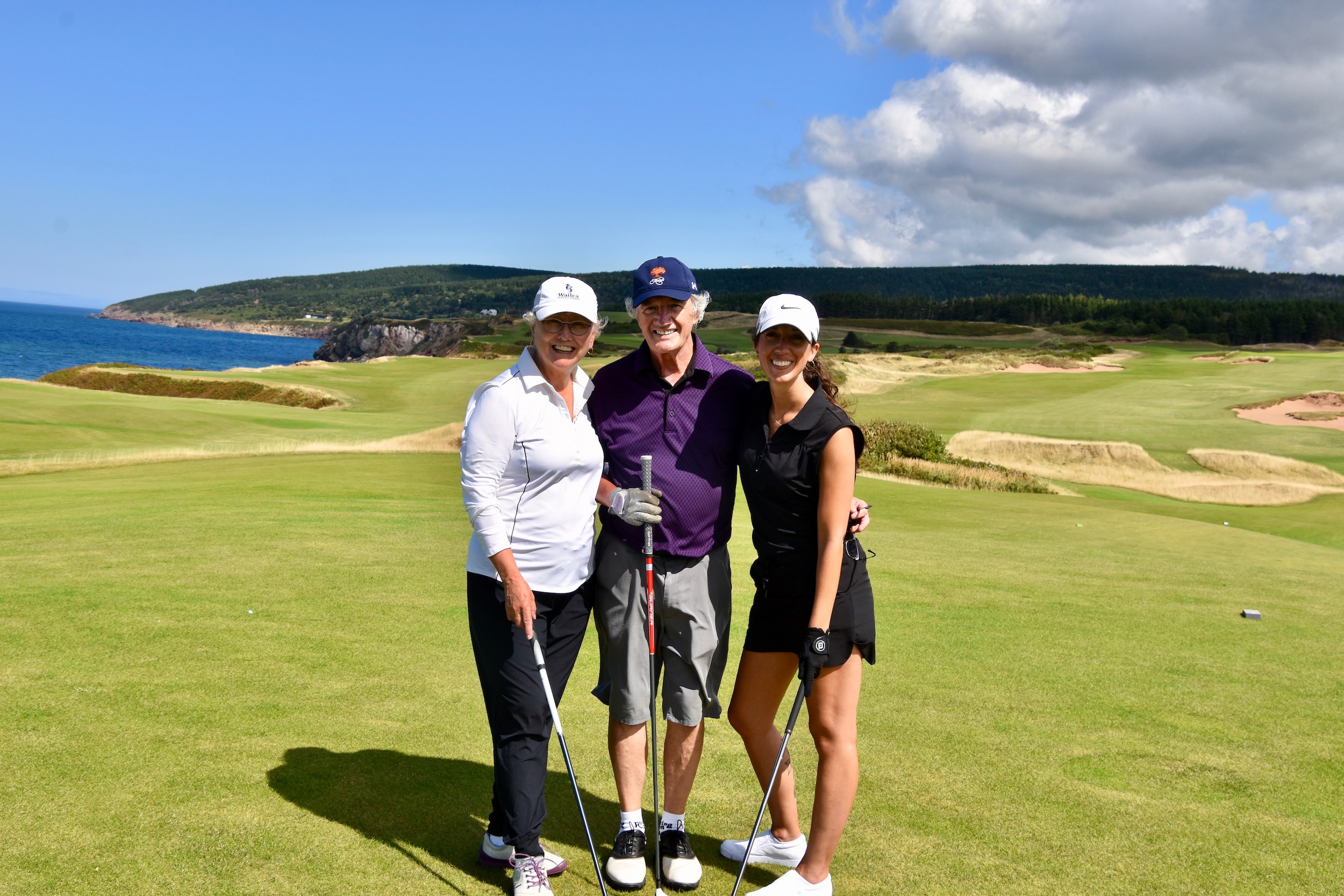
The people of Cape Breton are justly renowned for their friendliness and that comes through in spades for the employees of the Cabot Links resort. While we were warming up in 2016 on the practice area the course pro came over, introduced himself and asked if we’d like any help in getting ready to play. The tips he provided, gratis, unquestionably saved strokes on the course. Later on the first tee, he was happy to tell us about his experience walking the land with Bill Coore and the legendary Ben Crenshaw, when it was basically a forest. All he could see was the trees, while they saw great golf holes.
For our 2020 visit I had the assistance of Golf Cape Breton in securing tee times and a media rate for which I am very grateful. I had requested the earliest possible tee time and was given 8:24. I had assumed that there would be multiple groups out in front of us, probably starting around 7:30, but pulling into the parking lot it was empty. Edwin, the affable starter, told us we were the first group out and there were very few groups going out today. To say I was flabbergasted would be an understatement. Here we are on the #1 course in Canada and it’s almost like we are playing our own private course. While great for us, it was a stark indication of how much the loss of visitors from anywhere but Atlantic Canada has hurt the resort and the entire Inverness area.
OK, time to play. I’m going to describe the course hole by hole as I experienced it as updated by the most recent round., but if you’d like to read what Coore and Crenshaw had in mind for each hole click this link.
Cabot Cliffs #1 – 544 Yard Par 5
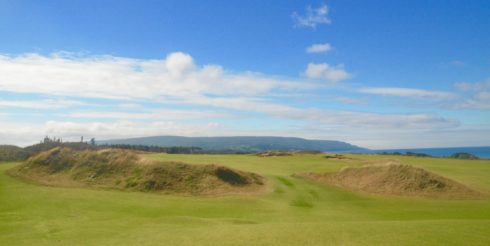
We are playing from the Silver tees which is just over 6,000 yards, but #1 playing at 544 yards makes it seem like we’ve chosen the blues. A number of us playing in 2016, played in Ireland in 2015 and I was immediately struck by the similarity of this hole and everything around it, to a number of the courses we played there. The traps and the mounds on #1 are particularly reminiscent of Portmarnock, just outside of Dublin. As opening holes go it’s pretty fair as long as you can hit three good shots in a row or two in the case of Frankie Duguay, who had an eagle putt right off the bat. In 2016, the fairways were in great shape, but the greens still needed to mature. 2020 has been a very difficult summer for Nova Scotian golf courses with one our driest ever. Still, the fairways at Cabot Cliffs have fared much better than most of the courses we have played this season. Below is a photo from the first tee in 2020 – a little less green, but not much.

In mentioning the similarity to Portmarnock, what really reminded me was the set of bunkers that line the first fairway. While the fairway is very wide, if you do get into those bunkers your round can get off to a bad start.
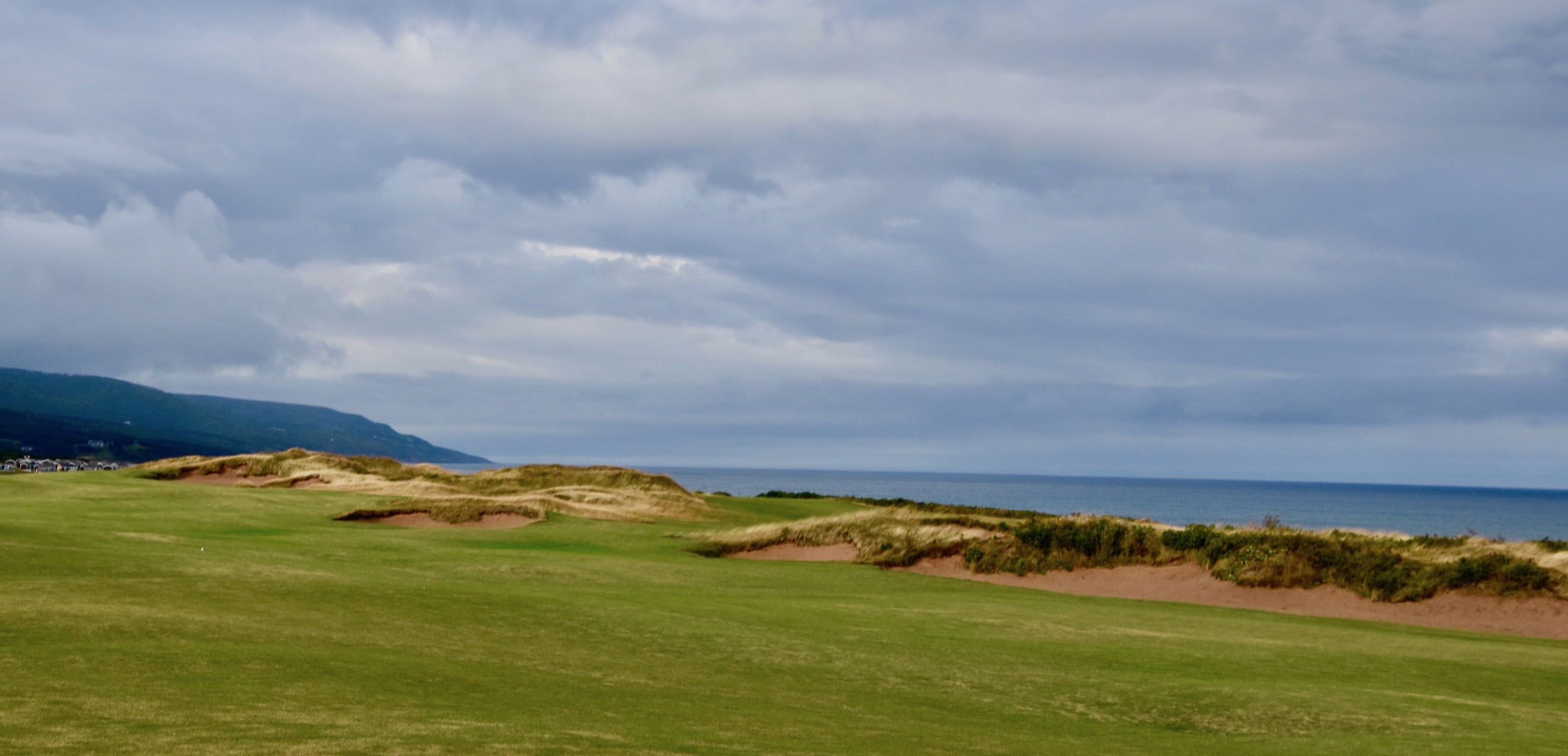
What has definitely changed for the better are the the greens which are now fully mature. They vary in size from medium to large with a good amount of undulation and are fast enough to cause poor putters, me for example, to have a lot more three putts than one putts. To offset this scoring dilemma you can always look around at the fabulous views you get from almost every green at Cabot Cliffs. You can also see that it is beginning to cloud over a bit. This is the opposite of what happened in 2016 when we started out with full sun and ended with cloudiness on the back nine. Today the forecast is the opposite with clouds early on and then clearing. That’s great because I can use the photos from 2016 on the front and those from 2020 on the back.
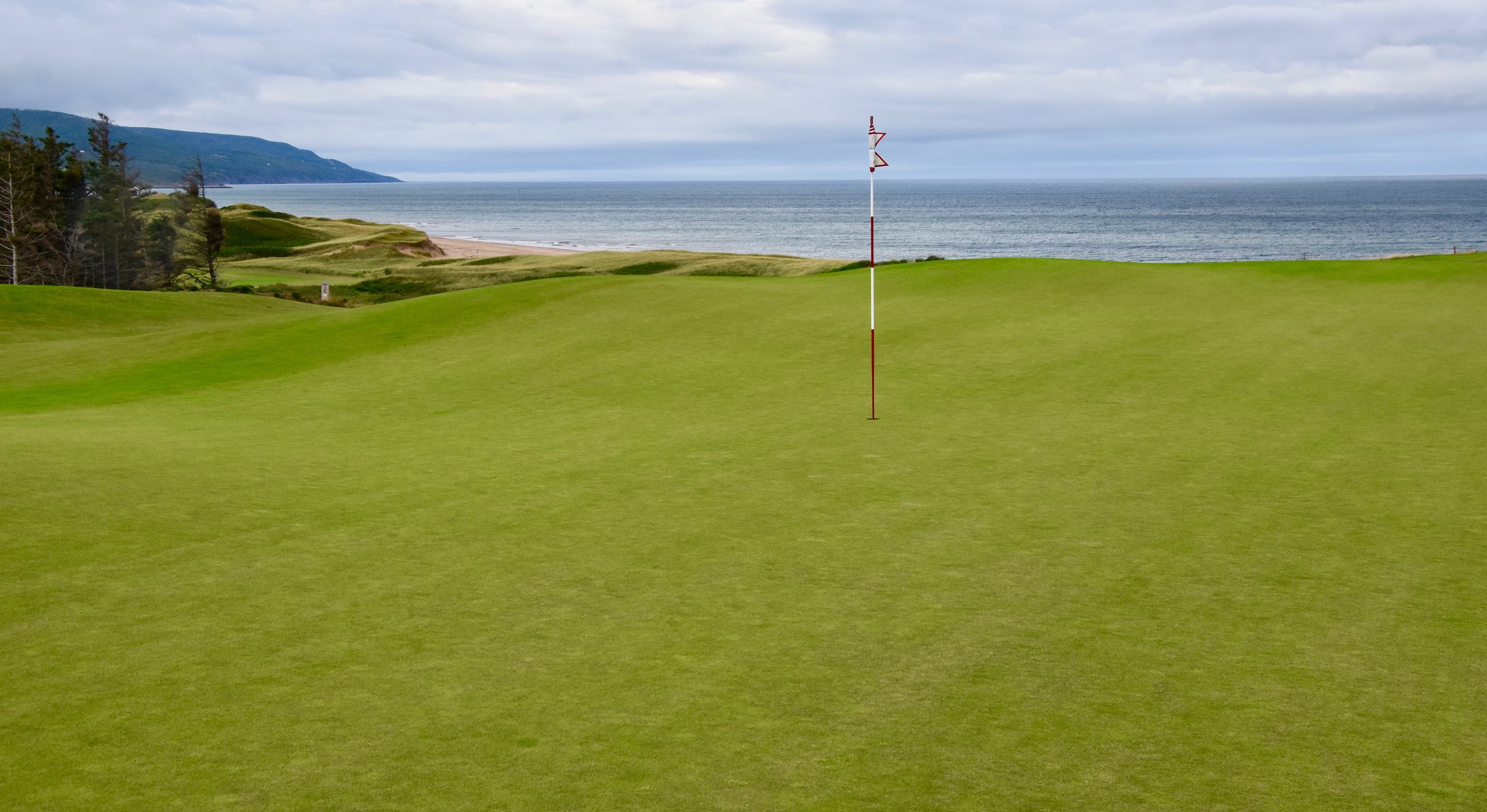
#2 – 305 Yard Par 4
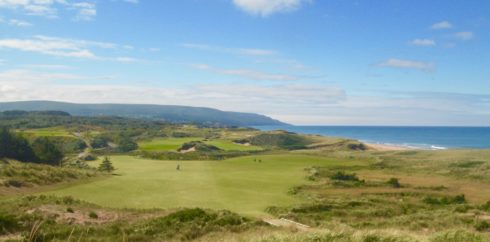
The second hole is truly stunning. This photograph does not do it justice. From an elevated tee, our foursome in 2016 had a lengthy discussion about the proper club to hit as there is a creek that you need to lay up to. On the other side is this massive dune that completely blocks the view of the green if you go straight off the tee. The proper play was to go right so you could see the pin on the second shot. Needless to say, I know that now after playing it. Then, I chunked my second into the fescue on top of the dune and racked up a double. Still, it was such a unique golf hole that I didn’t care.
On the more recent round I hit a very good drive, but still faced this daunting second shot with the pin directly behind the highest part of the mound. However, given the relative shortness of the hole it is not as difficult a shot as it first appears as long as you keep that dune out of your swing thoughts.
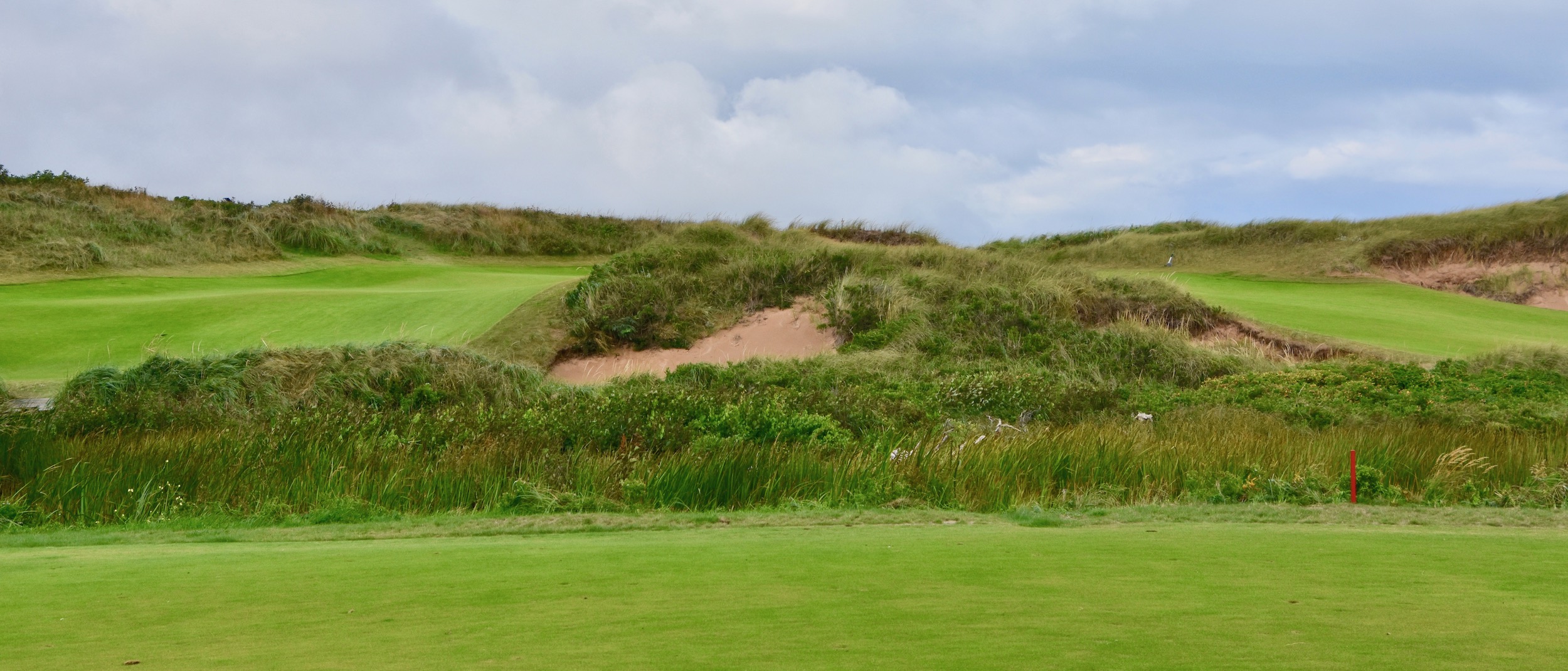
Cabot Cliffs #3 – 342 Yard Par Four
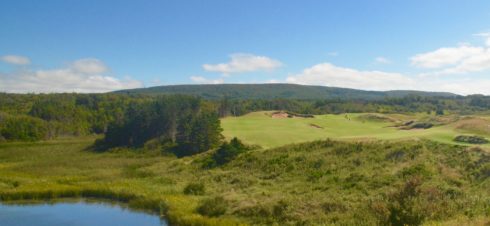
This is the first of a number of holes that, from the tee box, seem like impossible carries for the average golfer. Actually they’re not, but the trepidation involved inevitably leads to swinging too fast and the predictable result – at least I’m speaking for what I did. That trap up near the green is massive, certainly the largest in Nova Scotia and probably eastern Canada. Needless to say if you are in it, forget about a sand save, just think of surviving.
#4 – 191 Yard Par Three
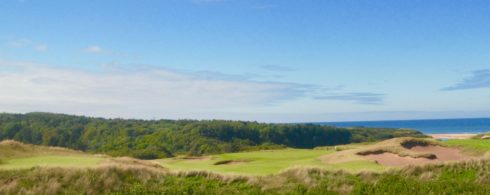
The first of the par threes and if this is typical, then it’s going to be a long day. It plays almost 200 yards and there’s a prevailing left to right wind. The flag is just over that huge bunker on the right and there are more bunkers behind it. The only choice is to hit at the left side of the green and hope the wind doesn’t affect it too much. Fat chance. In 2016 three out of four balls were pushed into the bunkers. The good news is that the sand in these bunkers is soft and predictable. As hard as they are to avoid, they are very easy to play out of – a fair compromise by Coore and Crenshaw. In 2020 playing out of the sand is not a requirement in many courses that due to Covid have stopped raking them. At Cabot Cliffs there are also no rakes, but the bunkers were maintained. Because the three of us in 2020 were playing a scramble we never actually had to play out of a bunker, but I did hit a few sand shots to confirm that they still play as they did four years ago – soft and consistent.
Cabot Cliffs #5 – 316 Yard Par Four

OK, in 2016 I’m standing on the tee and there’s nothing but marsh between me and the green, some 290 yards away as the crow flies. I’m not John Daly, so wtf do I do on this hole? The answer is to play it up the right hand side, but how much can I safely cut off? A lot as it turns out. A good drive will be rewarded by a long roll down toward the green and an apparently easy second shot. The only problem is that the green slants toward the marsh and landing it on the green will almost certainly lead to a bad result. By now I’m starting to realize that you cannot play Cabot Cliffs like a typical North American course. The ability to bump and run the ball onto the green is invaluable. Too bad I never learned how. Just wasted my best drive of the day.
Playing in 2020 I knew where to drive the ball and again got a great result, but was still faced with the very problematic second shot. With a bunker on the right preventing where you might want to land a bump and run due to the tremendous slope of the green you really need a precise approach just to the left of the bunker or you’ll end up in the bunker on the left. Once again, the great sea views ameliorate the situation. This hole is one that many golfers could easily get into a love/hate relationship with.
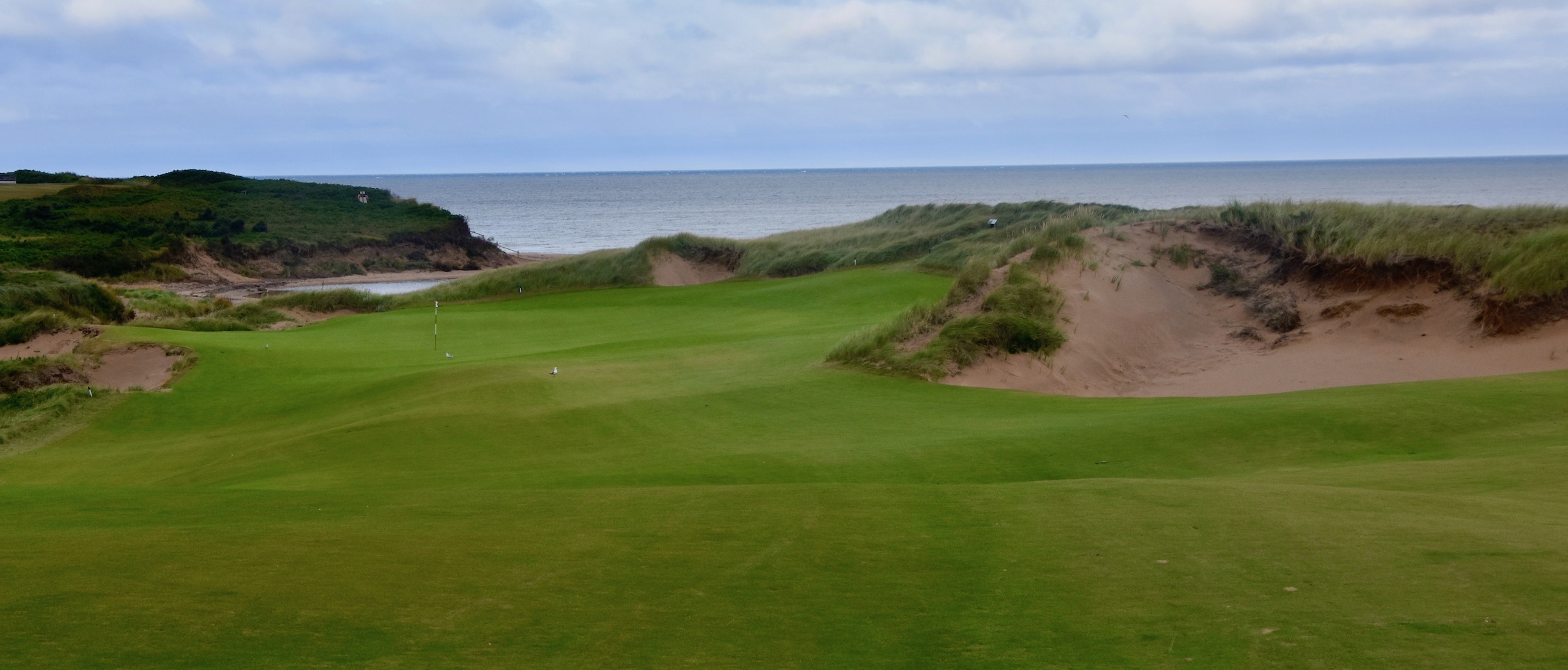
#6 – 144 Yard Par Three
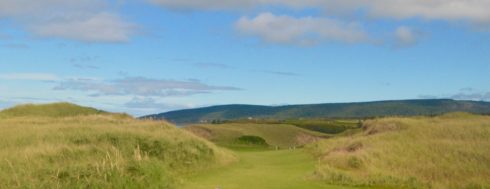
You don’t find many blind tee shots on par threes. I always thought they were unfair because you would never get to see a hole in one. Anyway, this tee shot isn’t just blind, you’re not even sure where the hell the green is. Amazingly, in 2016 after what only one of us thinks is a good tee shot, the three who thought they missed are on with birdie putts and the apparently good tee shot is long.
This is what you see as you round the dunes.
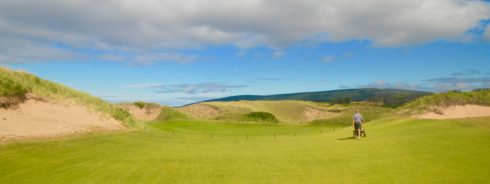
Pars all around to make up for the debacle on 5.
In 2020 the flag was placed where you could see it, but somewhat inexplicably that made the hole more difficult.

Getting to the green you can see why. The pin was placed in a position that is nigh on impossible to get near to from the tee as it is on the crest and the most likely result is that your ball will go down that very steep slope and end up where Alison did even though her shot looked to be right at the pin. In 2016 the pin was in the collection area which, although not visible from the tee, is actually much easier to get close to. Coore and Crenshaw wanted this hole to remind golfers of some of the great links par threes in Scotland and northern England and they certainly succeeded.
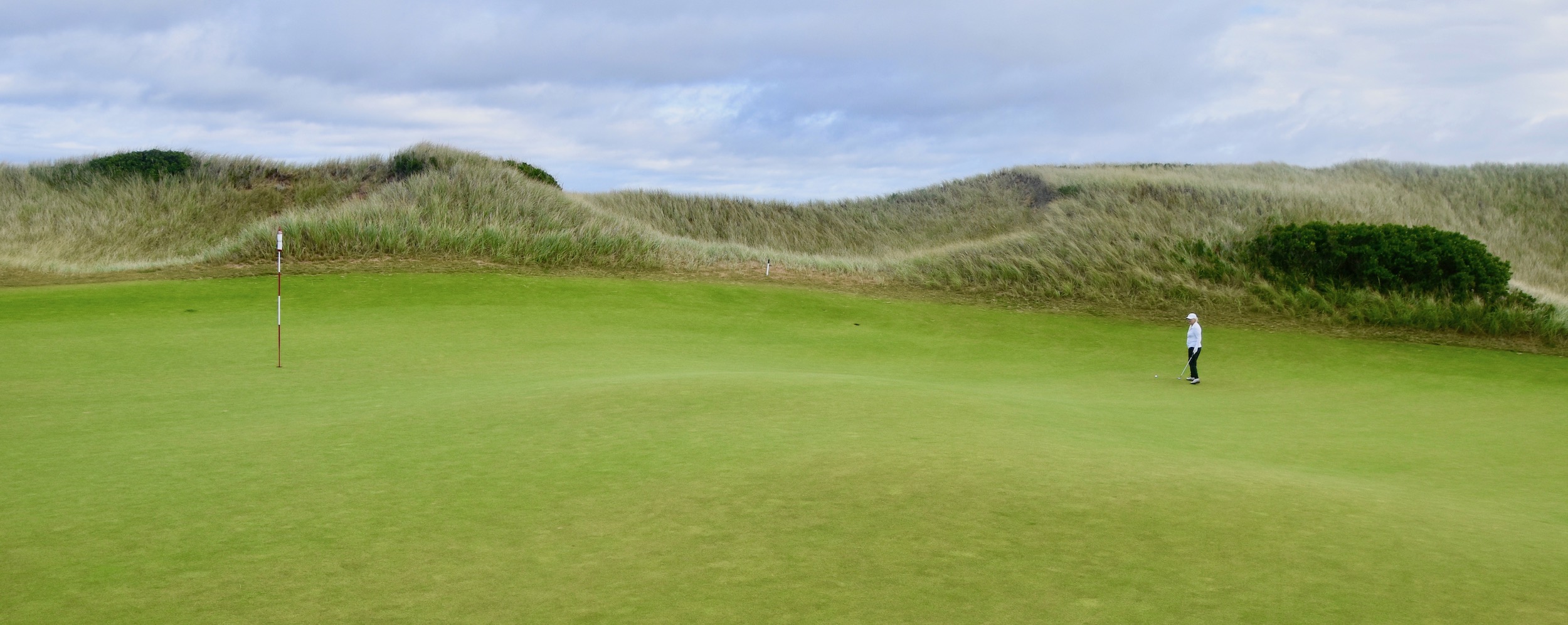
Here’s the view from #6 in 2016. Pretty spectacular.
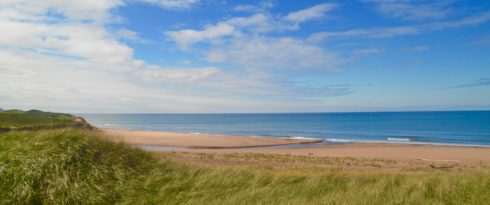
Cabot Cliffs #7 – 552 Yard Par Five
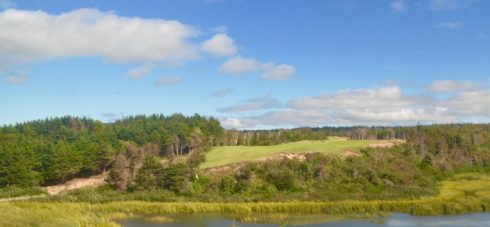
This is a hole that can give you the screaming Mimis. Two holes ago I lamented not having the length of John Daly, now I’m wondering if even he could make this drive. Once again, like #3, it’s not as long as it looks, but you’ll certainly need to unclench your buttocks as you watch your ball flight. Even though there’s no view of the ocean on this hole, it’s very beautiful with the marsh, the forest and the distant fairway.
Once you make the fairway, by way of drive or drop, this is the view looking back to the tee, seemingly hundreds of yards away.
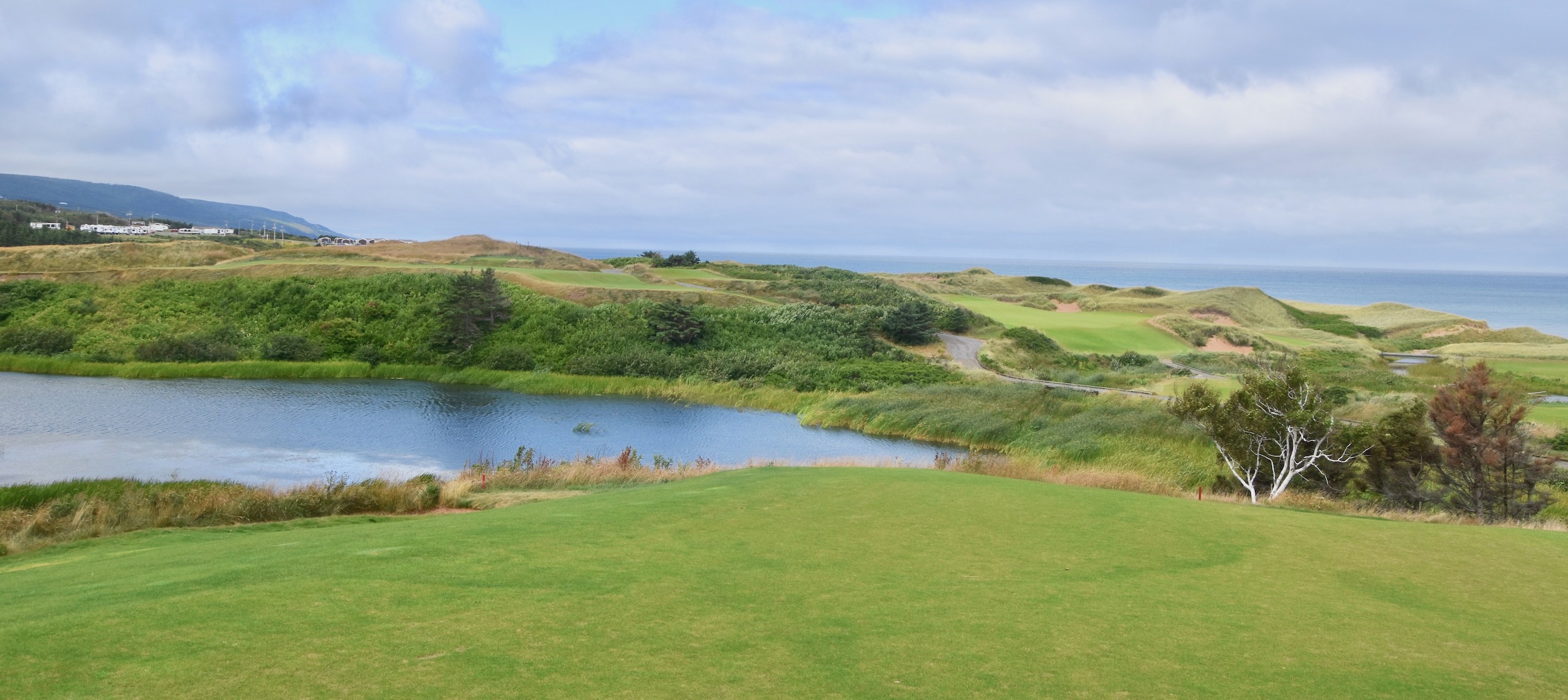
This the view of the second shot.
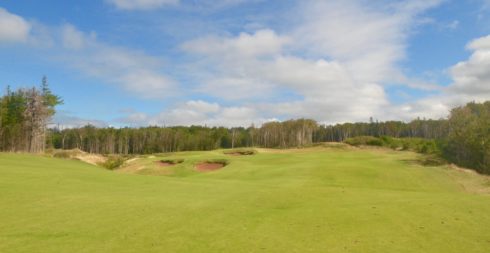
On the approach shot, what seemed like a very wide fairway suddenly becomes quite narrow with traps on the left and instant death on the right. So much for being rewarded for making a great drive.
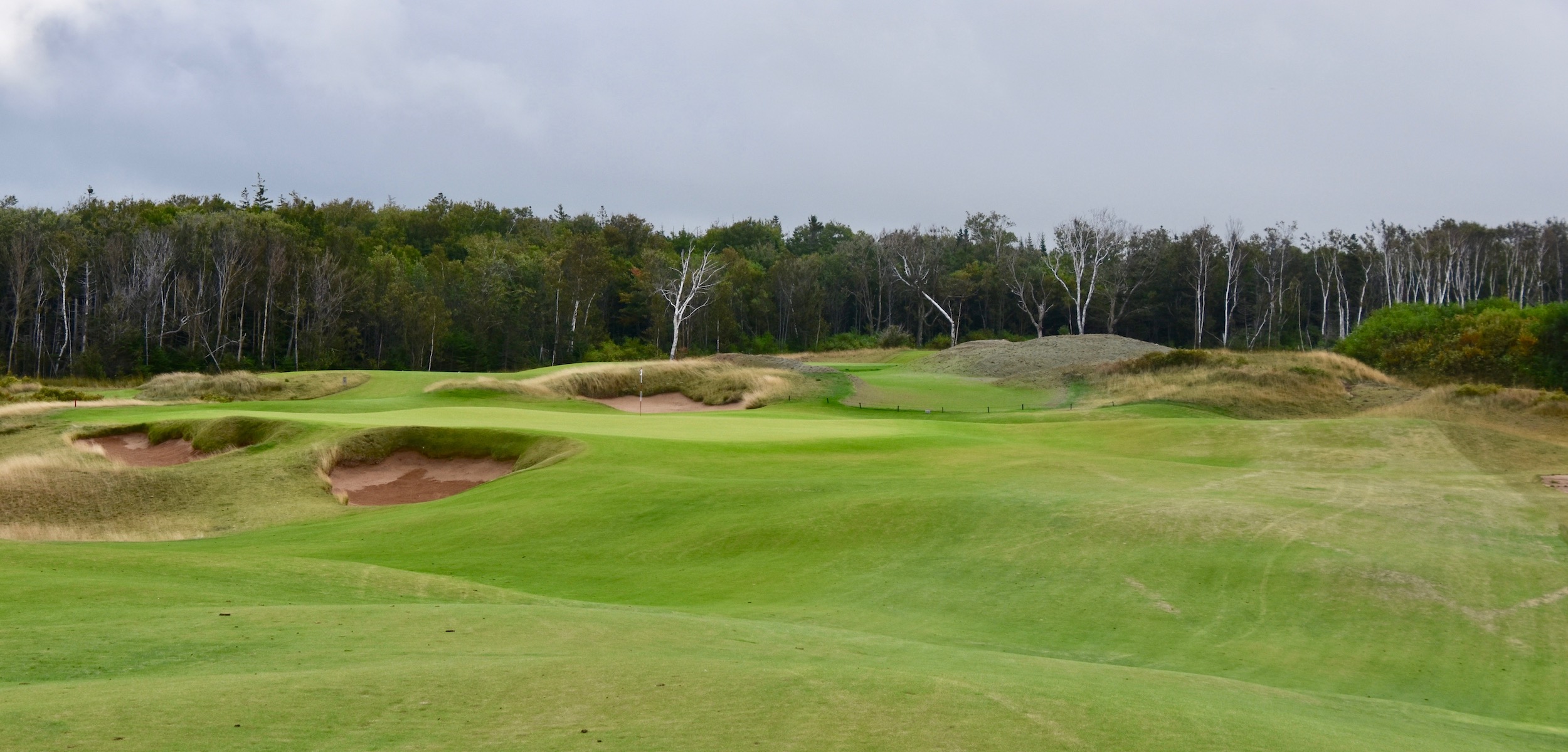
Never felt better to make a six in my life.
Nothing has changed since 2016. This is still a monster of a hole.
#8 – 493 Yard Par Five
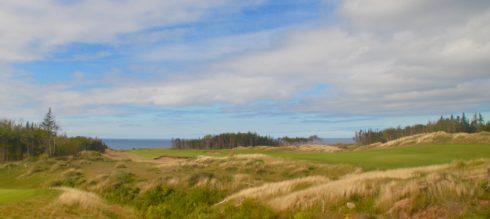
This is the third par 5 on the front and thank God it’s a bit easier than the first two. Take your drive out right and it plays longer than the posted 493 yards, but have some guts (or luck) and play it down the left side and you’ll get a lot of roll. A real chance for a birdie until you get to what is a Biarritz green, which means it has a huge swale in the middle, making a three putt a real possibility. What a piss off for the average golfer to get to a par 5 in two and then only get a par. Such is golf.
Like the previous hole, this one played very much as described above in 2020.
Cabot Cliffs #9 – 109 Yard Par Three

In 2016 You could see from the difference in the sky from #8 to #9 that it was starting to cloud over so the pictures weren’t as nice from then on in, but trust me, the holes get even better. Bill and Ben were up to the same tricks on this par three as on #3. The prevailing wind is left to right, the pin is on the right edge of the green and there are bunkers all down the right side. The wind here is much stronger than on #3. It looks like a fairly benign hole from the tee, but it’s not. The safe play here is to forget the pin, go left and hope for a two putt. Of, course, I never heed my own advice, so mark down a four out of the bunkers.
Here is a closer view in 2020, also cloudy, but trying to clear up. You also see what a sucker pin placement that is. Same advice as in 2016 – forget the pin and go for the left side.

If I have one complaint about Cabot Cliffs it is the very poor signage from hole to hole of which finding #9 tee is the worst example. Walking off #8 you inexplicably end up on the 10th tee box. If there had not been a crew member working nearby we still might be looking for the 9th tee. This is an easy fix and would speed up play. On the other hand most of the non-Atlantic Canadians who play here take a caddie so it’s not an issue for them.
#10 – 491 Yard Par Five
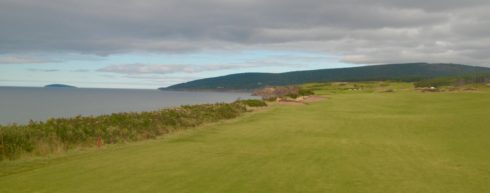
You know right off the bat that the back nine is going to be different from the front. Whereas, the sea was in view on most of the front nine holes, none actually played along it, although most of the holes have a true links feel to them. This is the view looking back from #10 tee.
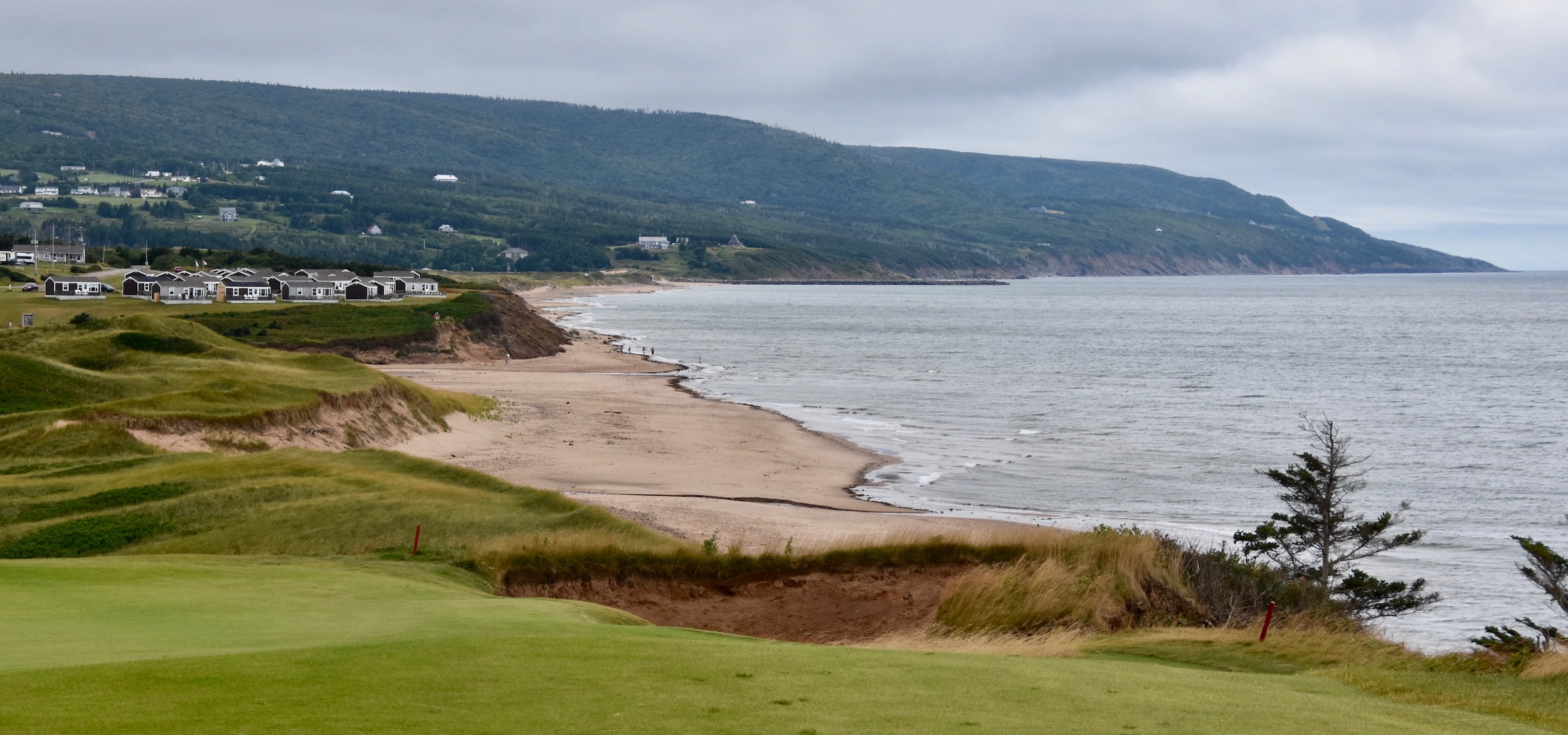
This is the view looking forward or north. One can see that the terrain has changed completely from dunes and beach to the cliffs for which the course is named. Playing the front nine you might be excused for thinking “Where are these cliffs everyone’s raving about?” Well, you are about to find out.
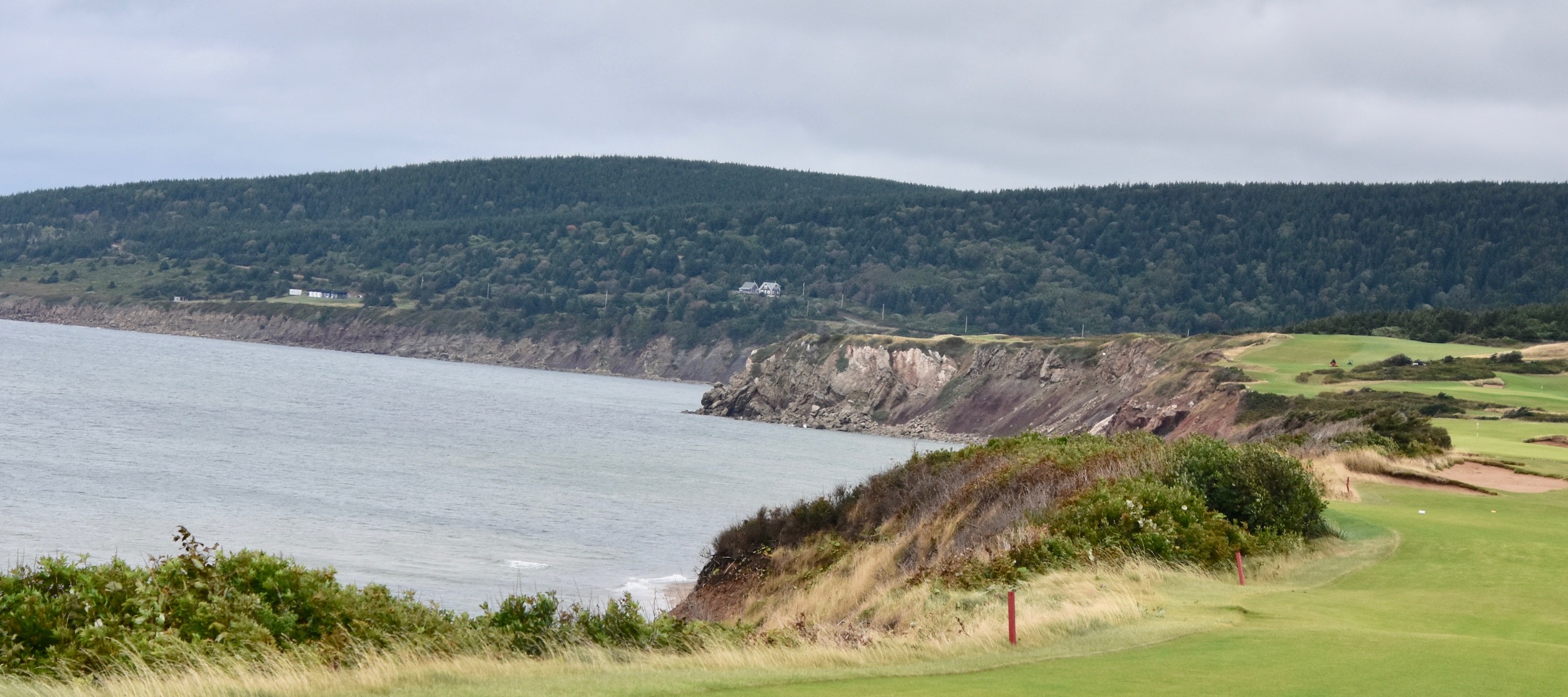
This is the first of a number of holes that do play along the water.
From No. 10 on you understand why the course is called Cabot Cliffs. The drop off on the left is very steep. You won’t be hitting any balls from down there as they occasionally do at Pebble Beach. This is the third par 5 in four holes and if you can avoid going over the cliffs you still have to cross a wide ravine right in front of the green as in the photo below. It’s very easy to think – two three woods and a wedge for a birdie putt, but much harder to achieve in real life. The upside is that it’s just so damn pretty that you really don’t care what your score is. Unlike Mark Twain, I’m not going to let a game of golf spoil this wonderful walk along the cliffs.
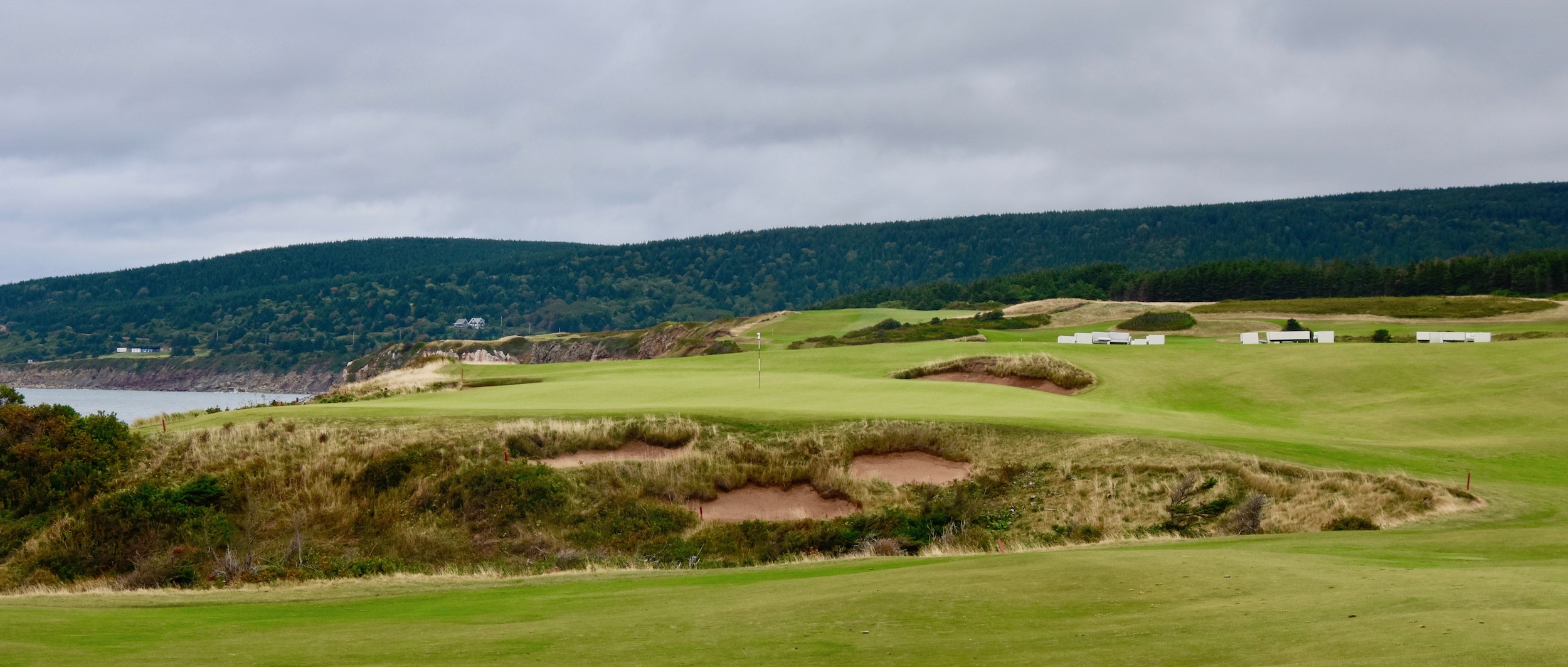
Cabot Cliffs #11 – 358 Yard Par Four

From this picture you might think that the clouds have dissipated, but I took it before we teed off in 2016. The 11th tee is actually just behind #1. This is a very tough par four as it is uphill and plays longer than the 358 yards it measures. Again, the scenery is mesmerizing.
Here is a photo from the tee taken in 2020 which gives a more close up view of the hole and the challenges it presents.

#12 – 195 Yard Par Three
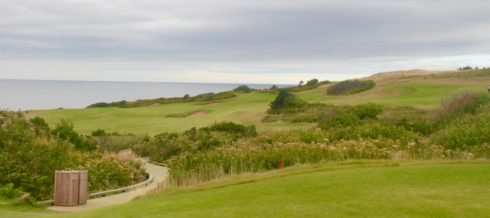
This is a just plain diabolical par three. At 195 yards, the pin, which is placed between the two traps on the right side of the green, is almost impossible to get close to. In 2016 we all tried to land it right of the green and roll down to the pin, but all rolled into the front bunker. Once again, the outstanding views tempered the urge to toss a club. In 2020 it was the same story. Alison hit what looked like the perfect shot up the right side and it seemed poised to roll onto the green and right down to the pin. Instead it caught the very last edge of grass above the bunker and rolled into it. As Maxwell Smart would say, “Missed it by that much.”
This 2020 photo shows the situation more clearly and just how narrow the space is between the two bunkers where you must land. Anything on the green above the pin is simply going to roll off. You can also see that it’s starting to clear up.

Cabot Cliffs #13 – 329 Yard Par Four

No. 13 is an uphill par four that has an unusual blind second shot. The green is shielded by a natural mound in front. The good news is that if you clear the mound, the green is bowl shaped so that you are likely to be closer to the hole than anticipated. Turned out to be an easy par for most of us in 2016.
#14 – 149 Yard Par Three

This is a beautiful looking par three that has a sharp pinnacle of gypsum sticking up well in front of the green. It’s not in play, but is intriguing to say the least. By now I’m starting to realize that the back nine is really quite a bit easier than the front, #12 excepted. If you choose the right club on this hole (hybrid 5 for me), the green is not hard to hold. In 2020 Alison made a natural par from below the green on the left side.
Cabot Cliffs #15 – 502 Yard Par Five

On paper this looks like a tough 500 plus yard par 5 with a blind tee shot and traps seemingly everywhere, but it’s really a paper tiger. If you can avoid the fairway bunkers off the tee (I didn’t in 2016), there is a steep drop to the green below. You are rewarded not only by the fantastic view on cresting the hill, but also by the fact your ball will roll forever. Getting on in two is possible, but it’s more likely you’ll be just in front and still have a good chance for birdie.
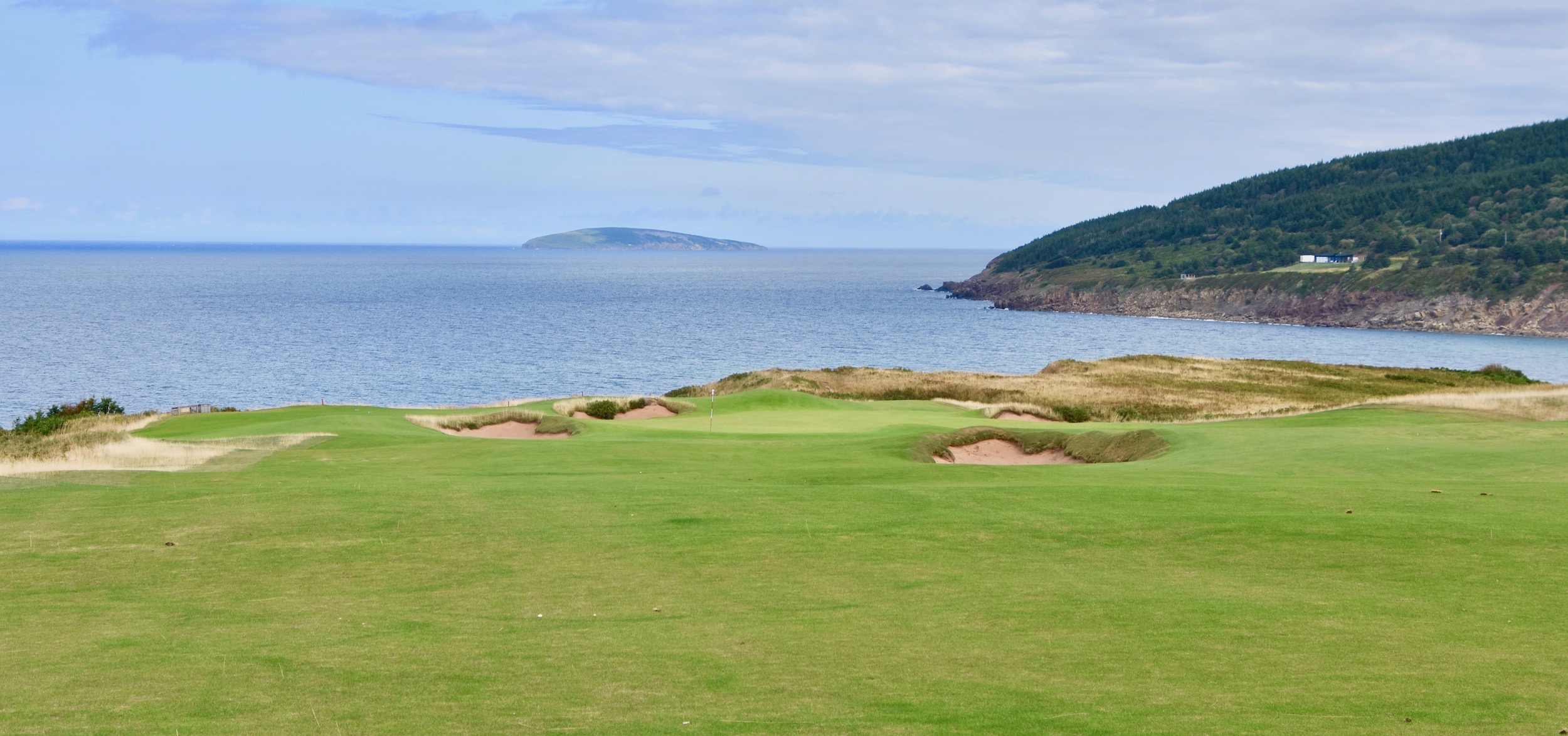 #15 Approach
#15 Approach
This is the best hole from which to get a view of Margaree Island just up the coast which many say reminds them of Ailsa Craig the small island visible from Turnberry famous for being the source of curling stones for centuries.
#16 – 119 Yard Par Three

If there is a signature hole on Cabot Cliffs it must surely be this out of the world par three. The photo gives no hint at just how steep those cliffs are and how intimidating this tee shot really is. You need to see it from above to appreciate that as shown in this photo from Cabot Links.
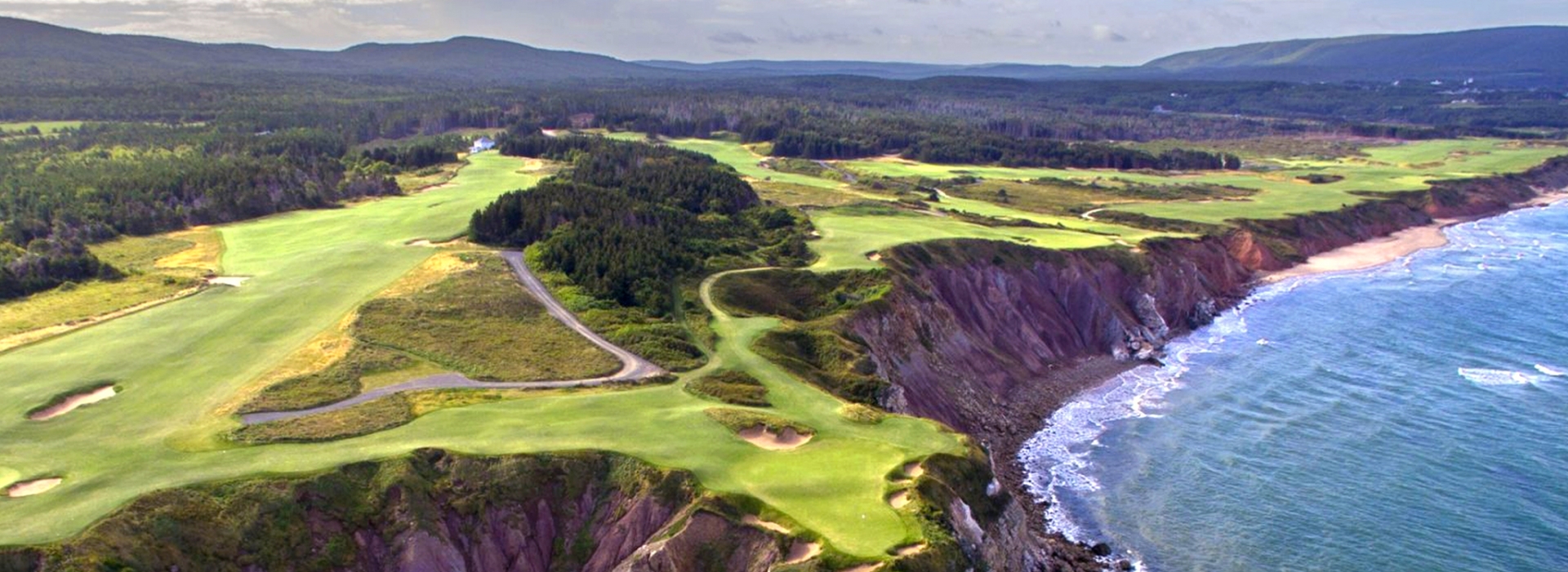
It reminded me of #2 at Ardglass, only in reverse.
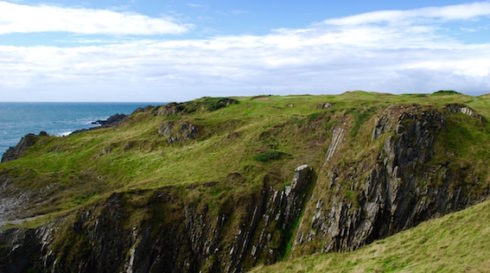
This hole is almost 100% carry over the cliffs to a green that has two levels which are visible in the aerial photo. From the silver tees it’s less than 120 yards, but the pin position and the wind make club selection problematic. I chose a nine, hit it well and we all thought it had cleared the green. When I walked up it was eight feet from the pin and I had my first birdie on Cabot Cliffs. I love this hole.
That was then, this now. In 2020, I was three strokes worse after watching my ball fail to make it and go screaming to its death on the rocks below. Same club, completely different result.
This is probably the most famous hole in Nova Scotia and perhaps all of Canada and one of the reasons, pre-Covid, people came from around the world to play Cabot Cliffs.
Cabot Cliffs #17 – 232 Yard Par Four

The 17th was so weird to figure out that I forgot to take a picture in 2016. It’s an easily driveable par four for big hitters that appears daunting from the tee because it’s a blind shot with the ocean on the right. Since you don’t know where the green is the tendency is to go left out of caution, but actually that’s where the trouble is. If you do clear the hill with a three or five wood the ball will go straight for the green or catch one of the bunkers around. Either way, par should be easy and the possibility of an eagle is very real.
For ordinary hitters like me this is the more likely scenario for the second shot, having bailed to the left in fear of putting two in a row into the ocean. Suddenly it’s not so easy anymore, but what about that view!
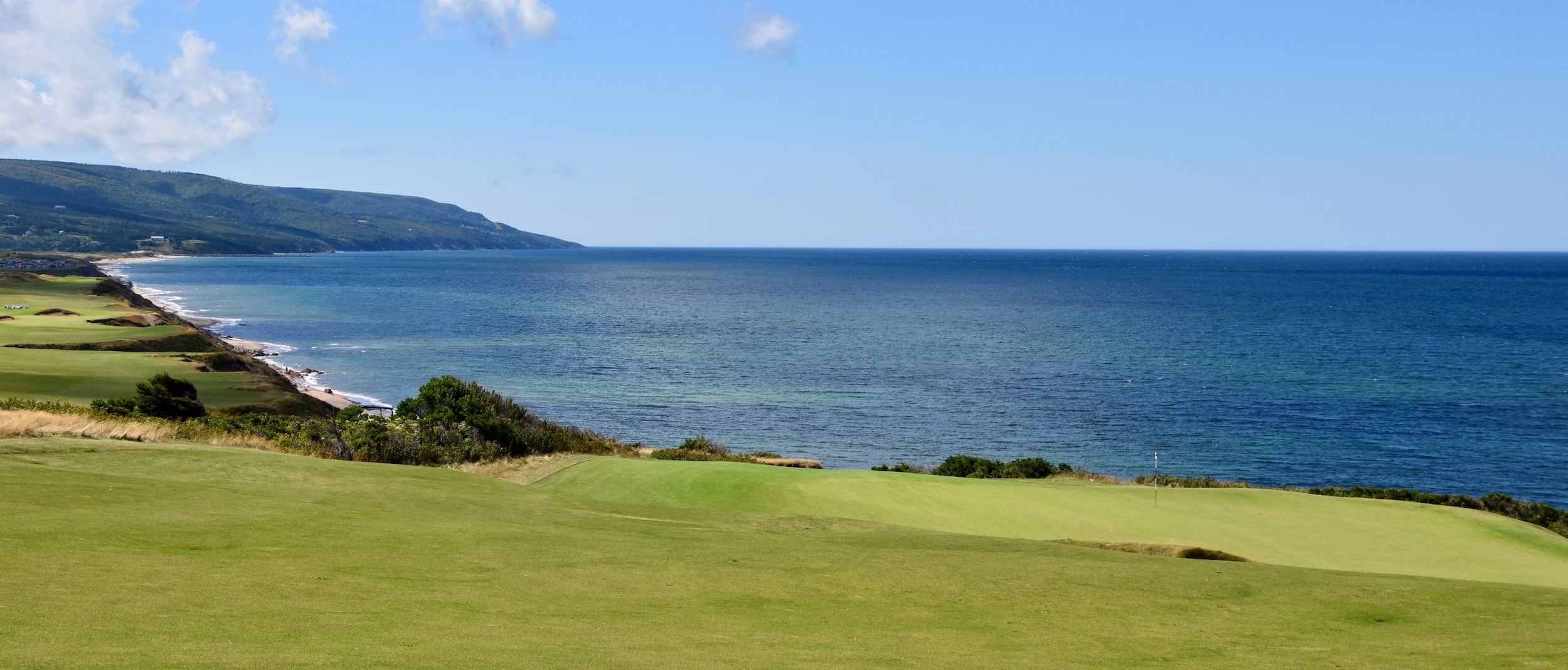
#18 – 482 Yard Par Five

What a superb finishing hole is 18. Assuming you don’t put it on the beach, it’s a relatively simple par five, but for two ravines that bisect the fairway. You need to clear them on your second and third shots so there’s two chances to screw up. Even if you do, the one thought in your mind will be “What a golf course!”
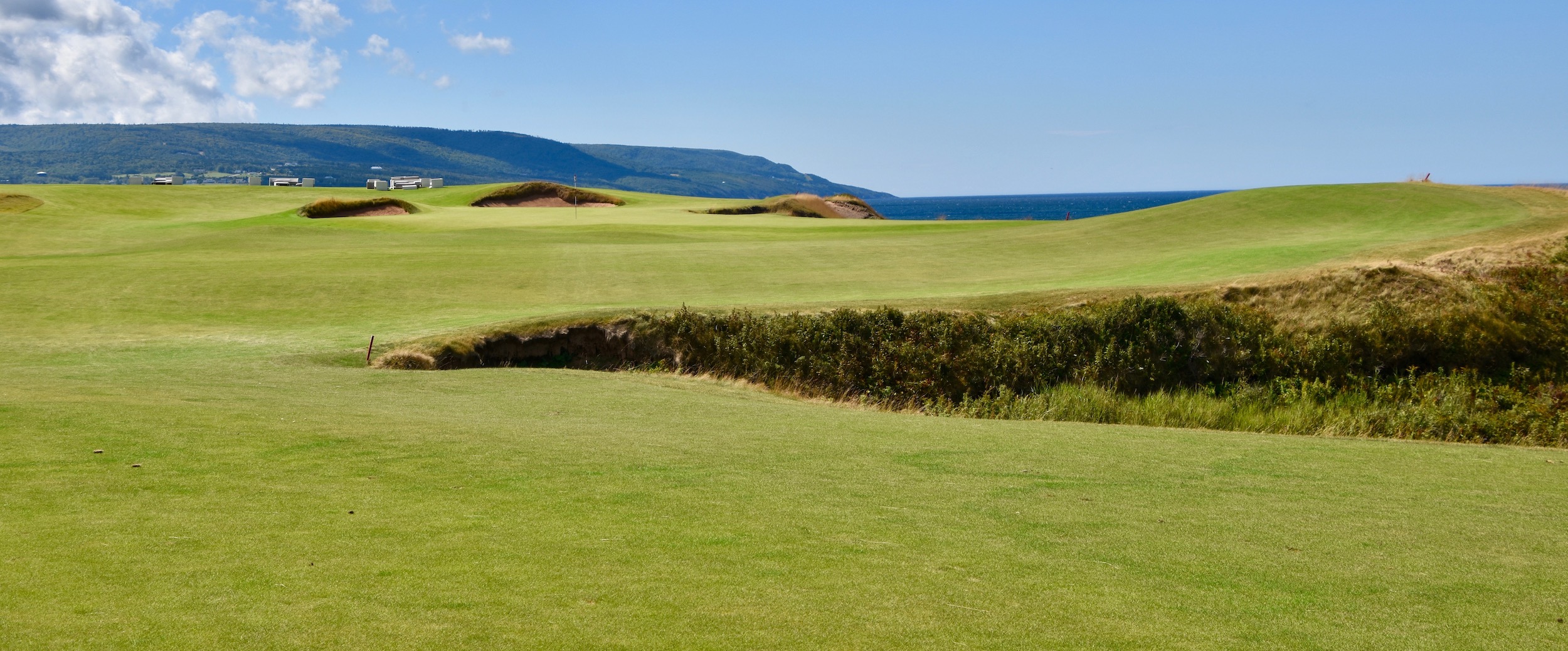
Closing Comments
Cabot Cliffs is a walking only course. I would seriously suggest you invest in a caddie as there are a lot of shots that require prior knowledge. At the very least, get a forecaddie for the group. The greens are not that hard to read, but that will probably change as they grow in and get faster (they have) Check the resort’s website for fall bargains. No matter what the cost, Cabot Cliffs is a bargain. The great news is that its sister course Cabot Links is also a true links course and rated #5 in Canada while nearby Highlands Links, a Stanley Thompson masterpiece, is rated #9. We Nova Scotians have no idea how lucky we are to have these gems right in our backyard. Make it a commitment to play them at least once in your life.
There are great golf courses on the mainland of Nova Scotia as well with Ron Joyce’s Fox Harb’r Resort being my favourite.

